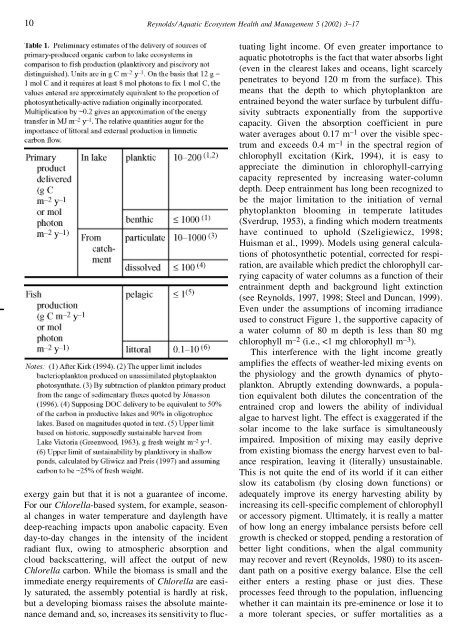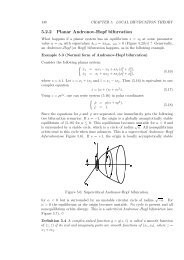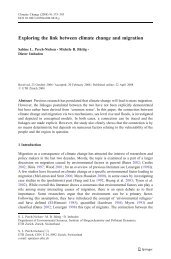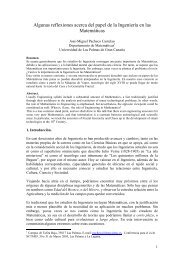Resilience in aquatic ecosystems - hysteresis, homeostasis, and ...
Resilience in aquatic ecosystems - hysteresis, homeostasis, and ...
Resilience in aquatic ecosystems - hysteresis, homeostasis, and ...
You also want an ePaper? Increase the reach of your titles
YUMPU automatically turns print PDFs into web optimized ePapers that Google loves.
10<br />
Reynolds/ Aquatic Ecosystem Health <strong>and</strong> Management 5 (2002) 3–17<br />
exergy ga<strong>in</strong> but that it is not a guarantee of <strong>in</strong>come.<br />
For our Chlorella-based system, for example, seasonal<br />
changes <strong>in</strong> water temperature <strong>and</strong> daylength have<br />
deep-reach<strong>in</strong>g impacts upon anabolic capacity. Even<br />
day-to-day changes <strong>in</strong> the <strong>in</strong>tensity of the <strong>in</strong>cident<br />
radiant flux, ow<strong>in</strong>g to atmospheric absorption <strong>and</strong><br />
cloud backscatter<strong>in</strong>g, will affect the output of new<br />
Chlorella carbon. While the biomass is small <strong>and</strong> the<br />
immediate energy requirements of Chlorella are easily<br />
saturated, the assembly potential is hardly at risk,<br />
but a develop<strong>in</strong>g biomass raises the absolute ma<strong>in</strong>tenance<br />
dem<strong>and</strong> <strong>and</strong>, so, <strong>in</strong>creases its sensitivity to fluctuat<strong>in</strong>g<br />
light <strong>in</strong>come. Of even greater importance to<br />
<strong>aquatic</strong> phototrophs is the fact that water absorbs light<br />
(even <strong>in</strong> the clearest lakes <strong>and</strong> oceans, light scarcely<br />
penetrates to beyond 120 m from the surface). This<br />
means that the depth to which phytoplankton are<br />
entra<strong>in</strong>ed beyond the water surface by turbulent diffusivity<br />
subtracts exponentially from the supportive<br />
capacity. Given the absorption coefficient <strong>in</strong> pure<br />
water averages about 0.17 m –1 over the visible spectrum<br />
<strong>and</strong> exceeds 0.4 m –1 <strong>in</strong> the spectral region of<br />
chlorophyll excitation (Kirk, 1994), it is easy to<br />
appreciate the dim<strong>in</strong>ution <strong>in</strong> chlorophyll-carry<strong>in</strong>g<br />
capacity represented by <strong>in</strong>creas<strong>in</strong>g water-column<br />
depth. Deep entra<strong>in</strong>ment has long been recognized to<br />
be the major limitation to the <strong>in</strong>itiation of vernal<br />
phytoplankton bloom<strong>in</strong>g <strong>in</strong> temperate latitudes<br />
(Sverdrup, 1953), a f<strong>in</strong>d<strong>in</strong>g which modern treatments<br />
have cont<strong>in</strong>ued to uphold (Szeligiewicz, 1998;<br />
Huisman et al., 1999). Models us<strong>in</strong>g general calculations<br />
of photosynthetic potential, corrected for respiration,<br />
are available which predict the chlorophyll carry<strong>in</strong>g<br />
capacity of water columns as a function of their<br />
entra<strong>in</strong>ment depth <strong>and</strong> background light ext<strong>in</strong>ction<br />
(see Reynolds, 1997, 1998; Steel <strong>and</strong> Duncan, 1999).<br />
Even under the assumptions of <strong>in</strong>com<strong>in</strong>g irradiance<br />
used to construct Figure 1, the supportive capacity of<br />
a water column of 80 m depth is less than 80 mg<br />
chlorophyll m –2 (i.e.,






